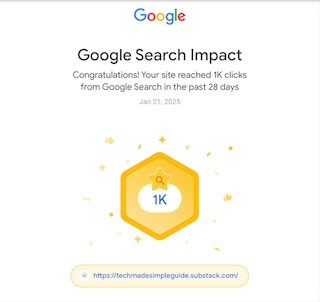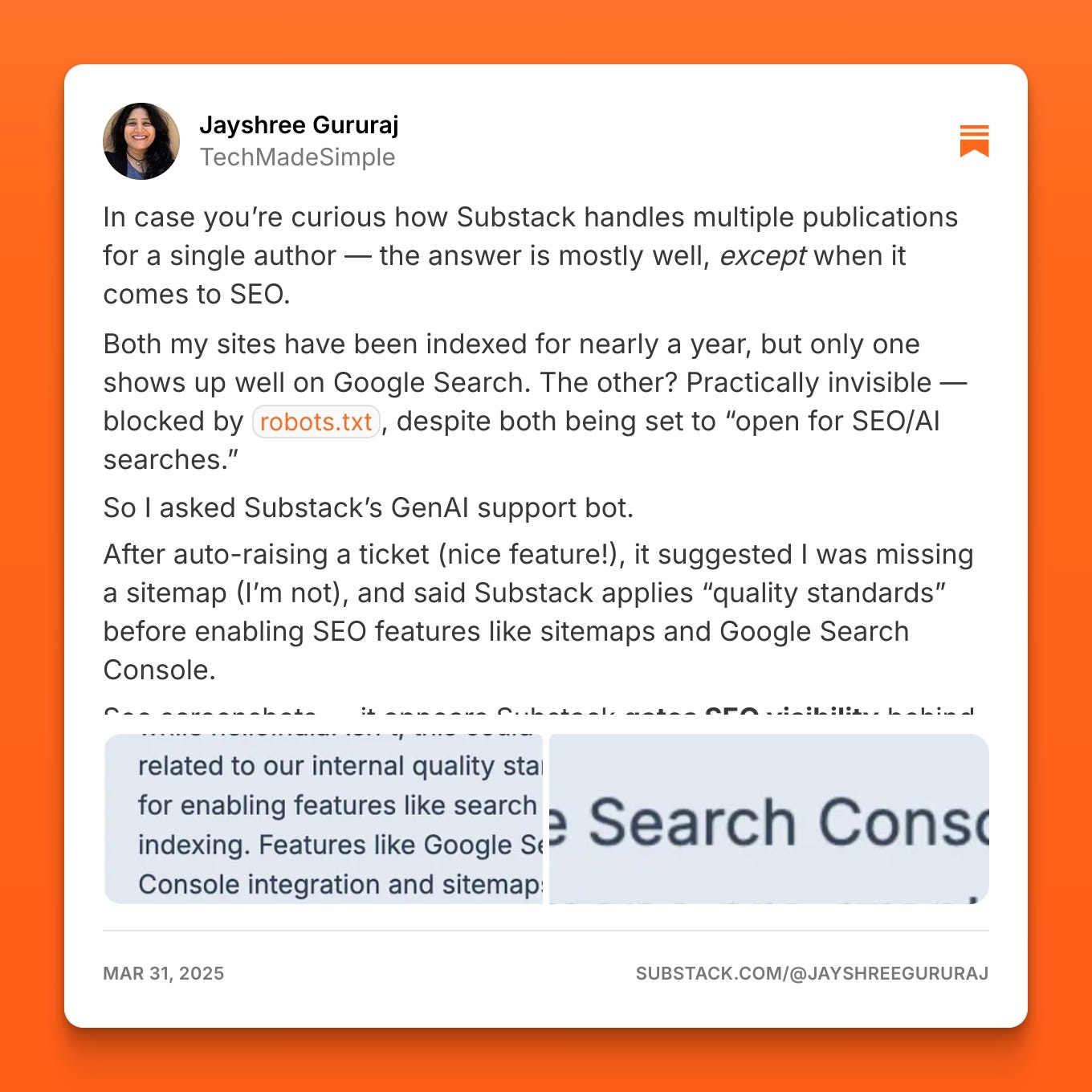Hello Everyone! Welcome to new readers! A big thank you to all the subscribers who’ve recently upgraded—I truly appreciate your support.
I handcraft each post at TechMadeSimple, bringing you deeply researched and curated tech advice—designed to simplify complexity, tools, workflows, and digital strategies. As a paid subscriber, you now have access to 80+ practical, insight-rich articles and how-to videos.

Curious about how to get discovered on Google?
For now, you can still shape how your site appears on Google—before generative AI search takes over completely.
The first step?
Make sure your site is indexable.
That simply means allowing search engines like Google to view (or ‘crawl’) your content - assessing its authenticity, quality, and relevance - so it can appear in search results.
Why this Matters
Google remains the dominant search engine. It has over 80% market share in the U.S. and more than 90% globally. If your site isn’t indexed, it won’t appear in search results—no matter how good your content is, whether on Substack, Ghost, beehiiv or your own website.
The rules for search engine optimization or SEO are complex (as you probably know).
Digital creators use a range of strategies to improve visibility and reach.
But with generative AI search results rising, the rules are about to dramatically shift.
Already, changes are visible, as Google now features an AI-generated result first—using genAI-sourced sites (based on a variety of factors still being shaped by Gemini, its genAI engine)!
Whether this is what users actually want to see is an entirely different discussion. Also worthy of discussion, another day, is the downward slope of Google search results in terms of quality—as the platform increasingly prioritizes revenue.
For now, savvy users rely on tailored keywords to bypass AI summaries and get specific results.
But there is still a need to ensure that your content appears in keyword searches related to your topic—this hasn’t changed.
Soon, the key question will be: how do you get genAI to cite you as a source?
So, where should you start?
Build credibility with current search methods - through quality content, thoughtful keyword choices, and indexing.
Whether Bing or Google, search engines follow a similar path to offer the best matches to their users - excluding sponsored results.
In just three months after setup of this site, I went from zero search discoveries to 600 clicks in a 28-day period. Over six months, that number steadily climbed to an average of 1,000 clicks every 28 days.
Beyond the clicks (which track who follows the link to your site), the publication registered 63.1k impressions, appeared in the top five Google search results for certain keywords, and ranked in the top ten for several trending searches.
Being featured on the first page - and in the top ten - for the right keywords is a major win when the results align with your content goals.
It’s the kind of outcome SEO experts chase with paid ads and digital pretzel twists.
Interestingly, once indexing was in place, I also began receiving traffic from non-Google search engines like DuckDuckGo, and even Kazaa.
I now know exactly which articles are performing best—and the specific keyword searches that lead users to this publication.
Remember: if a search query lists your site, it means users are actively looking for the kind of content you offer—and clicking through to learn more.
A single click can lead to multiple page views, a subscription, or continued listing as a high-quality result. That builds credibility and momentum - something that may benefit you even more as genAI begins to shape future search.
To put it in perspective: achieving 1,000 clicks in 28 days and 63k+ impressions in under six months – without paid ads, traffic boosts, backlinks or social media – is a solid result. 😉
With quality content, proper indexing, aligned keywords, and consistency, you can replicate it.
This post is the intro to a 3-part paid series on how to get discovered through Google Search.
I focus on the minimal steps you need to take to make the engine work for you.
In three posts, I’ll walk you through each of these key steps in detail:
Submit your site for indexing
Ensure your site has a sitemap—a structured layout of your content
Confirm that your site is being indexed
Use relevant keywords and clear headlines for your content
Review search results to identify keyword trends
Tweak your content based on what’s working (or not)
Each post includes walkthroughs, screenshots, how-to videos, and real examples—so you can apply them directly to your own site.
You’ll see what keywords users are searching to find your content—and how to use that data to your advantage.
I’ll also show you how to set up keywords in your posts so that search algorithms better match your content to your audience—and how to refine your setup based on real indexing feedback.
Finally, I’ll address Substack-specific caveats (shared in this note below) that may impact your search performance.
So, let’s get started!





